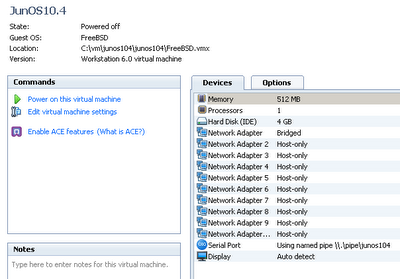This lab is used to emulate a common network topology which is two offices has two network connections. One primary connection as main usage, and second connection will be used as failover purpose only. No load balancing requirement at this time.
R5 and R6 can be considered as two branches core switch or firewall. R1 and R2 are acting as edge routers connecting to peer router R3 and R4 in another office.
Basic LAB regarding to how to setup logic router and ospf in JUNOS can be referred to previous posts:
OSPF between two JunOS routing instances
test> show configuration
## Last commit: 2012-01-29 07:03:41 UTC by test
version 10.4R3.4;
system {
backup-router 10.50.2.1;
root-authentication {
encrypted-password “$1$MsDQp3dk$uxdtlK7LKSqp4mHjg/zxZ1”; ## SECRET-DATA
}
login {
user test {
uid 2000;
class super-user;
authentication {
encrypted-password “$1$XKhC35Ei$9ED4o245Ts.jyQ2BqeeQR/”; ## SECRET-DATA
}
}
}
services {
ftp;
telnet;
web-management {
http {
port 80;
}
}
}
syslog {
user * {
any emergency;
}
file messages {
any notice;
authorization info;
}
file interactive-commands {
interactive-commands any;
}
}
}
logical-systems {
r1 {
interfaces {
em1 {
unit 13 {
vlan-id 13;
family inet {
address 10.1.13.1/24;
}
}
unit 15 {
vlan-id 15;
family inet {
address 10.1.15.1/24;
}
}
}
lo0 {
unit 1 {
family inet {
address 10.1.1.1/32;
}
}
}
}
protocols {
ospf {
area 0.0.0.0 {
interface lo0.1;
interface em1.13;
interface em1.15;
}
}
}
routing-options {
router-id 10.10.1.1;
}
}
r2 {
interfaces {
em2 {
unit 24 {
vlan-id 24;
family inet {
address 10.1.24.2/24;
}
}
unit 25 {
vlan-id 25;
family inet {
address 10.1.25.2/24;
}
}
}
lo0 {
unit 2 {
family inet {
address 10.1.1.2/32;
}
}
}
}
protocols {
ospf {
area 0.0.0.0 {
interface em2.24;
interface em2.25;
interface lo0.2;
}
}
}
routing-options {
router-id 10.1.1.2;
}
}
r3 {
interfaces {
em3 {
unit 13 {
vlan-id 13;
family inet {
address 10.1.13.3/24;
}
}
unit 36 {
vlan-id 36;
family inet {
address 10.1.36.3/24;
}
}
}
lo0 {
unit 3 {
family inet {
address 10.1.1.3/32;
}
}
}
}
protocols {
ospf {
area 0.0.0.0 {
interface em3.13;
interface em3.36;
interface lo0.3;
}
}
}
routing-options {
router-id 10.1.1.3;
}
}
r4 {
interfaces {
em4 {
unit 24 {
vlan-id 24;
family inet {
address 10.1.24.4/24;
}
}
unit 26 {
vlan-id 26;
family inet {
address 10.1.26.4/24;
}
}
}
lo0 {
unit 4 {
family inet {
address 10.1.1.4/32;
}
}
}
}
protocols {
ospf {
area 0.0.0.0 {
interface em4.24;
interface em4.46;
interface lo0.4;
}
}
}
routing-options {
router-id 10.1.1.4;
}
}
r5 {
interfaces {
em5 {
unit 15 {
vlan-id 15;
family inet {
address 10.1.15.5/24;
}
}
unit 25 {
vlan-id 25;
family inet {
address 10.1.25.5/24;
}
}
}
lo0 {
unit 5 {
family inet {
address 10.1.1.5/32;
}
}
}
}
protocols {
ospf {
area 0.0.0.0 {
interface em5.15;
interface em5.25;
}
}
}
routing-options {
router-id 10.1.1.5;
}
}
r6 {
interfaces {
em6 {
unit 36 {
vlan-id 36;
family inet {
address 10.1.36.6/24;
}
}
unit 46 {
vlan-id 46;
family inet {
address 10.1.46.6/24;
}
}
}
lo0 {
unit 6 {
family inet {
address 10.1.1.6/32;
}
}
}
}
protocols {
ospf {
area 0.0.0.0 {
interface em6.36;
interface em6.46;
}
}
}
routing-options {
router-id 10.1.1.6;
}
}
}
interfaces {
em0 {
unit 0 {
family inet {
address 10.50.2.230/24;
}
}
}
em1 {
vlan-tagging;
}
em2 {
vlan-tagging;
}
em3 {
vlan-tagging;
}
em4 {
vlan-tagging;
}
em5 {
vlan-tagging;
}
em6 {
vlan-tagging;
}
}
routing-options {
static {
route 0.0.0.0/0 {
next-hop 10.50.2.1;
retain;
no-readvertise;
}
}
}
——————————————————————–
verifications:
test> show ospf neighbor logical-system r1
Address Interface State ID Pri Dead
10.1.13.3 em1.13 Full 10.1.1.3 128 37
10.1.15.5 em1.15 Full 10.1.1.5 128 36
test> show ospf neighbor logical-system r2
Address Interface State ID Pri Dead
10.1.24.4 em2.24 Full 10.1.1.4 128 35
10.1.25.5 em2.25 Full 10.1.1.5 128 36
test> show ospf neighbor logical-system r3
Address Interface State ID Pri Dead
10.1.13.1 em3.13 Full 10.10.1.1 128 34
10.1.36.6 em3.36 Full 10.1.1.6 128 33
test> show route protocol ospf logical-system r3
inet.0: 13 destinations, 13 routes (13 active, 0 holddown, 0 hidden)
+ = Active Route, – = Last Active, * = Both
10.1.1.1/32 *[OSPF/10] 00:00:48, metric 1
> to 10.1.13.1 via em3.13
10.1.1.2/32 *[OSPF/10] 00:00:38, metric 3
> to 10.1.13.1 via em3.13
10.1.1.4/32 *[OSPF/10] 00:00:38, metric 4
> to 10.1.13.1 via em3.13
10.1.15.0/24 *[OSPF/10] 00:00:48, metric 2
> to 10.1.13.1 via em3.13
10.1.24.0/24 *[OSPF/10] 00:00:38, metric 4
> to 10.1.13.1 via em3.13
10.1.25.0/24 *[OSPF/10] 00:00:43, metric 3
> to 10.1.13.1 via em3.13
10.1.46.0/24 *[OSPF/10] 00:00:48, metric 2
> to 10.1.36.6 via em3.36
224.0.0.5/32 *[OSPF/10] 00:04:52, metric 1
MultiRecv
test> ping 10.1.1.3 logical-system r5
PING 10.1.1.3 (10.1.1.3): 56 data bytes
64 bytes from 10.1.1.3: icmp_seq=0 ttl=63 time=2.235 ms
64 bytes from 10.1.1.3: icmp_seq=1 ttl=63 time=1.759 ms
64 bytes from 10.1.1.3: icmp_seq=2 ttl=63 time=2.118 ms

